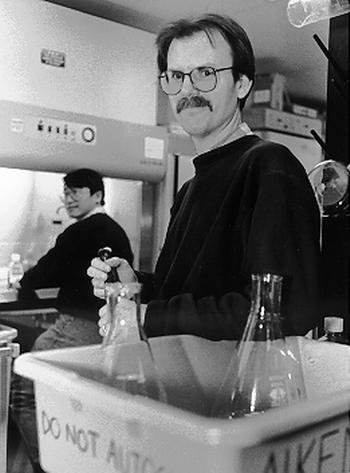Investigators track path HIV virus takes into cells

Christopher Aiken, Ph.D., is investigating the HIV replication cycle. Photo by Donna Jones Bailey.
Basic research into the life cycle of the HIV virus being conducted at Vanderbilt University Medical Center is giving scientists new insights into how the virus actually works its way into the body's cells.
Two proteins that affect the ability of the HIV virus to transform its RNA into the DNA needed to infect the nucleus of a cell have been targeted by VUMC researchers for further investigation.
"The complexity of the HIV replication cycle needs to be understood in more detail. These two viral proteins play essential roles in that replication cycle," said Christopher R. Aiken, Ph.D., assistant professor of Microbiology and Immunology and winner of last year's Vice Chancellor's Faculty Scholar Award.
The two proteins, Virion infectivity factor (Vif) and Negative Factor (Nef), are found only in HIV-1 and HIV-2, the viruses that affect humans, and SIV, the form of the virus that affects certain species of monkeys.
"When these accessory genes have been mutated in the laboratory to produce defects in Nef and Vif, not only do the mutant viruses replicate poorly, but infected monkeys don't get sick," said Aiken.
HIV and SIV are members of a family of viruses called retroviruses. Normally, when a retrovirus infects a cell, the RNA genome of the virus is copied into DNA which then integrates into the host cell's DNA.
DNA ‹ basically the cell's instruction booklet ‹ allows the cell to perform various bodily functions by giving instructions to different parts of the cell. Reverse transcription is the process by which the viral RNA gets copied into DNA.
After the viral DNA gets into the nucleus of a cell and combines with the cell's DNA, that cell is then infected with the virus and dies.
One novel feature of the Nef and Vif proteins is that they do not seem to be needed for the virus to enter the cell but they do seem to be necessary for the virus to undergo efficient reverse transcription.
This discovery has led Aiken to theorize that there is another process between entry into the cell and reverse transcription, called uncoating, that HIV must undergo before being able to reverse transcribe itself from RNA into the DNA used to infect the cell.
In this uncoating step, it is theorized that the virus unfolds itself so that it can efficiently convert its RNA into DNA. The virus, which enters the cell in the form a round ball, must unfold itself in exactly the right way in order to infect the cell.
"What we see when we look at this through biochemical tests is that the HIV falls apart very quickly and accurately once it gains entry into the cell," said Aiken.
The next step in Aiken's research is to develop a system to examine the uncoating system in vitro.
"By looking at the uncoating of the virus we should be able to better nail down the functions of Nef and Vif in the HIV life cycle. In addition, the work may lead to the development of novel assays for drug screening," said Aiken.
Although the work done in Aiken's lab is not directed at vaccine development, it could lead to HIV medication for those who have already contracted the disease.
"Because HIV is so skillful at becoming resistant to various drugs, it is important to identify as many useful viral targets for therapy as possible, said Aiken.
"If we can figure out exactly how Vif and Nef work in the virus, then there will be a better chance at developing drugs to disrupt their functions."













